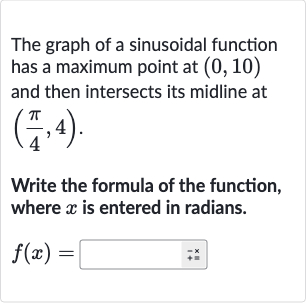Full solution
Q. The graph of a sinusoidal function has a maximum point at and then intersects its midline at .Write the formula of the function, where is entered in radians.
- Identify Maximum Point: The maximum point of the sinusoidal function is at , which means the amplitude is the distance from the midline to the maximum, and the vertical shift is the midline value. Since the maximum value is and it occurs at , we can infer that the function is a cosine function that has been shifted up.
- Determine Midline and Amplitude: The midline of the function is at , which is the average of the maximum and minimum values. Since we have a maximum at , the amplitude is . Therefore, .
- Calculate Period: The function intersects its midline at . Since the midline is at and this is a cosine function, this point represents a quarter of the period of the function. Therefore, the full period is . The period of a cosine function is given by , so .
- Find Horizontal Shift: Since the function is a cosine function with a maximum at , there is no horizontal shift, so .
- Finalize Function Equation: We have determined that , , , and the midline . The equation of the function is therefore .
- Finalize Function Equation: We have determined that , , , and the midline . The equation of the function is therefore .Substituting the values of , , , and into the equation, we get .
More problems from Write equations of cosine functions using properties
QuestionGet tutor help
QuestionGet tutor help
QuestionGet tutor help
QuestionGet tutor help
QuestionGet tutor help
QuestionGet tutor help
QuestionGet tutor help
QuestionGet tutor help
QuestionGet tutor help

